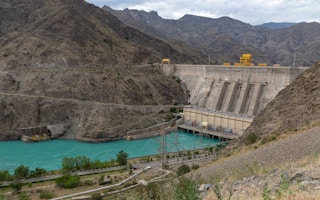The world is set to face more headaches in power generation and water supply as dams silt up, a United Nations (UN) study warns.
To continue reading, subscribe to Eco‑Business.
There's something for everyone. We offer a range of subscription plans.
- Access our stories and receive our Insights Weekly newsletter with the free EB Member plan.
- Unlock unlimited access to our content and archive with EB Circle.
- Publish your content with EB Premium.
Reservoirs that feed the world’s 50,000 biggest dams will fill up with enough sediments by 2050 to lose the equivalent of a years’ worth of water needed in India, China, Indonesia, France and Canada combined, researchers wrote.
Sediment build-up in the reservoirs behind dams is largely unavoidable as rivers will always carry rocks and sand downstream. Apart from reducing the amount of water that can be stored for use in dry seasons, large debris can also damage hydropower turbines.
The authors of the study, published in December in open-source journal Sustainability, applied average sedimentation rates from past research to dams, registered in 150 countries, since the year the dams were built.

Estimated loss of dam storage capacity by country in 2050. Japan is set to be one of the hardest hit. Image: Perera, Williams and Smakhtin.
Many old structures in Europe and North America have already lost up to 25 per cent of their initial capacity in 2022, above the global average of 16 per cent, the authors found. Elsewhere, Japan is particularly affected – some of its dams are over a century old, and in total reservoir capacity is down 40 per cent.
By 2050, Japan’s capacity loss would be close to 50 per cent, matching that of Seychelles, a country of islands off East Africa. The United States, Canada and many European countries would lose around 30 per cent of their dam capacity.
“The overall magnitude of water storage losses due to sedimentation is quite disturbing,” the authors say, adding that the losses are unlikely to be offset by new dams, since fewer are being constructed today compared to the 1950s.
Vulnerable Asia
Apart from Japan, dam and hydropower projects in Asia are relatively young, so reservoirs in the region are less silted up.
However, China and India, the two most populous countries in the world, are among the world’s largest builders of dams, sharing over 20,000 projects between them. Major economies Japan and South Korea are also in the top 10.
“In Asia, the region where 60 per cent of the world’s population lives, water storage is crucial in sustaining water and food security. It will face a more challenging future if it loses 23 per cent of its water storage in large dams,” the study’s authors wrote.
The study also concedes that detailed studies of individual dams could return different results. A 2009 study in China found that average reservoir capacity is already down 66 per cent, a much bigger drop than the 10 per cent decline in the latest UN study. In Brazil and Lesotho, the UN study’s figures are marginally higher than those of locally produced studies.
“Clearly, this study’s results need to be interpreted by local authorities with consideration given to local specifics and factors,” said co-author Dr Duminda Perera, a researcher at the institute for water, environment and health of the United Nations University, based in Canada.
“What is most important to underline is the disturbing overall magnitude of water storage losses due to sedimentation. This adds to the list of world water development issues we need to address,” Perera added.
Dr Li Dongfeng, a geography researcher from the National University of Singapore not involved in the UN study, said that heavily silted dam reservoirs face additional risks, such as being breached by extreme flooding caused by typhoons, as well as local earthquakes.
The UN study did not account for the effect of climate change on sedimentation rates. A separate research paper last year, which Li co-authored, found that higher temperatures could melt frozen rivers and cause running ones to carry more debris. Replanting forests upstream could reduce soil running into rivers, Li said.
Solutions to dam sedimentation have been proposed, but they come with drawbacks. For example, dredging silt can be costly. Sediment can be flushed downstream, but the sudden input of silt downstream could decimate wildlife. Raising dam walls comes with structural concerns. Building special sediment bypasses is gaining traction for its smaller environmental impact, the UN study said.
Hydropower dams can produce renewable electricity to replace pollutive fossil fuels, but they have also been found to cause harm by altering a river’s profile and flooding riverbanks upstream, where forests and human settlements once stood.

















